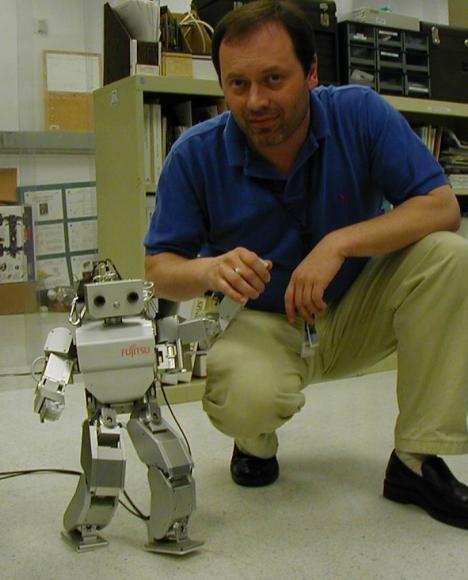By Joseph Kunkle

BABY STEPS (Dr. Adrian Stoica)
By Joseph Kunkle
R2-D2 and C-3PO would be proud. A little Fujitsu robot at the Jet Propulsion Labs in Pasadena is learning, just like a human infant, to survive in a hostile world, and like any attentive father, Dr. Adrian Stoica hopes that his little HOAP-2 robot, or more specifically, all humanoid, or human-shaped robots, will eventually be utilized for much more than just an extremely expensive toy.
Last Tuesday, Stoica was at RCC to give a talk on the future possibilities of robotics and the increased importance of the human-shaped robot in the future.
Having machines that look like us will be necessary to make deep space exploration possible, and also to do some of the more onerous jobs here on earth. The ones that need two hands and two legs, like for cleaning up toxic waste. The main thrust of the lecture was the importance of research into the human shape applied to robots.
In the past the Honda corporation tried to market robot butlers, but the humanoid robot is still more for Hollywood science-fiction than it is for fetching you a Coke out of the fridge. Is there a market for another labor-saving device for obese Americans who have too much of their labor saved already? I say definitely… Maybe. Fights over who gets the remote control will become tame by comparison.
For the humanoid robot, most problems of actual mobility have already been solved. Honda’s personal service robot ASIMO is capable of moving smoothly through a house, avoiding obstacles like tables, chairs, and moving people; and according to Honda, recognizing people by sight. Asimo was designed to be a personal helper for disabled humans, with possible application in fighting fires or handling explosives and nuclear waste. And though it resembles a conscious being, Asimo is still very much a machine, like a PC with arms and legs.
For some strange reason, there are already objections to the morality of creating a robot that looks like a human being. A robot in any other shape seems to be acceptable, it is just the human shape that draws criticism. More understandable is the criticism of the eventual use of artificial intelligence, and whether it would be appropriate to create a robotic body with human intelligence. After all, a robot that is an intelligent, autonomous being might by definition possess a soul.
The philosophical question here is whether it would be proper to create an artificial intelligence in a being created in man’s image, much like God created Man in his image. Artificial intelligence in your toaster is one thing, but this is different, somehow.
The humanoid robot would certainly be far more useful possessing its own free will and artificial intelligence. How much artificial intelligence would that be? Just enough to get the job done but not enough for the gadgets to form a union. That seems safe, but there is still the moral issue of creating an awareness and then enslaving it. The rabbit hole goes a long way down on this one.
Naturally these robots would be kept deliberately stupid to keep them from getting uppity, much like the lowest classes in Aldous Huxley’s Brave New World. They are the slaves and we are the masters. There are those who question the morality of doing this. I can’t figure out why.
What is the big deal? Corporations will manufacture these things, and they will be designed to eventually break down. They will only last long enough for us to trade them in on a newer model. You might as well get attached to your washing machine (but don’t give it a name).
At issue here is the lack of a philosophical definition of what it means to be an intelligent robot. I think, therefore I am… I think. Whenever philosophy crops up things are bound to get complicated.
What is it that constitutes a soul? Intelligence? Robots got that covered. Free thought? No robot could survive very long without that. How about moisture? Nope, we got them beat there.
So moisture is what separates man from those he will be served by. So much for philosophy; a robot butler would be SO COOL!
For Dr. Stoica and his infant HOAP-2, the field of robotics is an area that is only beginning to be appreciated by mainstream America. For the rest of us, it might take a few years before a supply of these little things will become affordable. There are currently 30 ASIMOs in the world right now so I will probably have to wait a bit more than I did for my first iPod, but when they do hit the market, I’m getting one of those babies!






